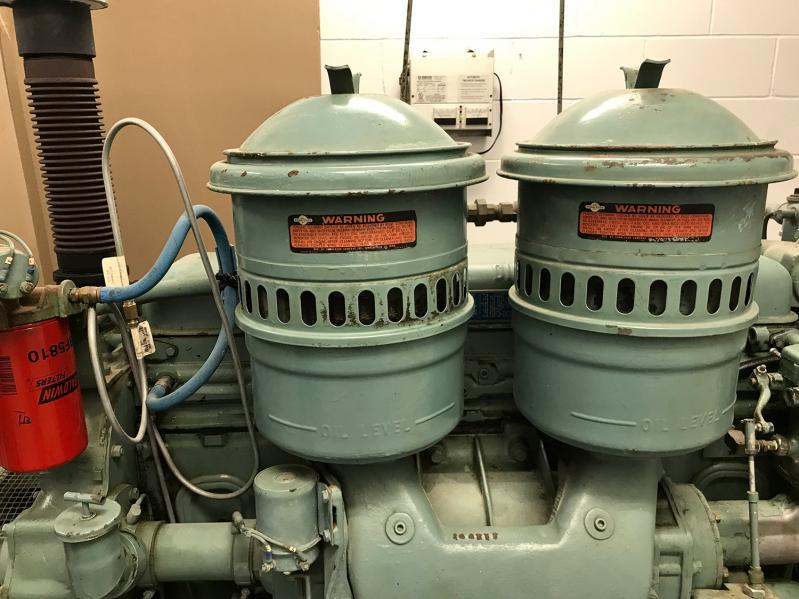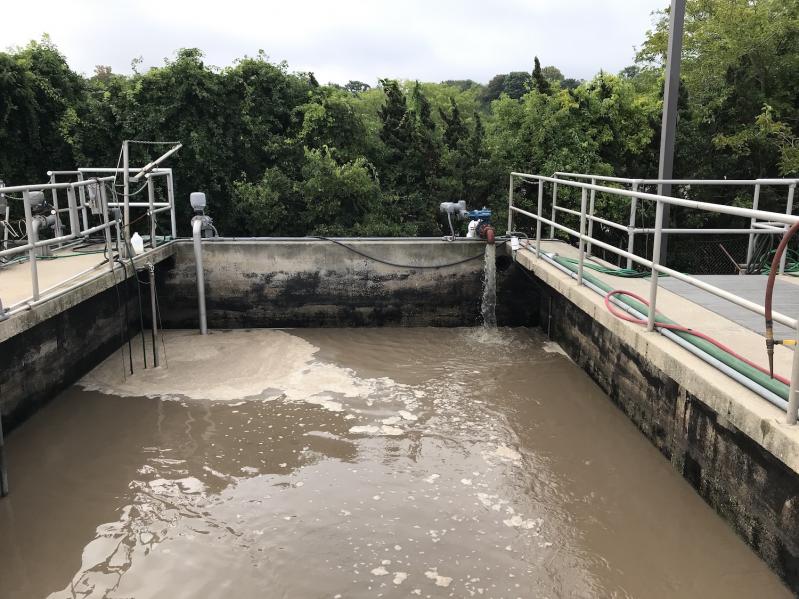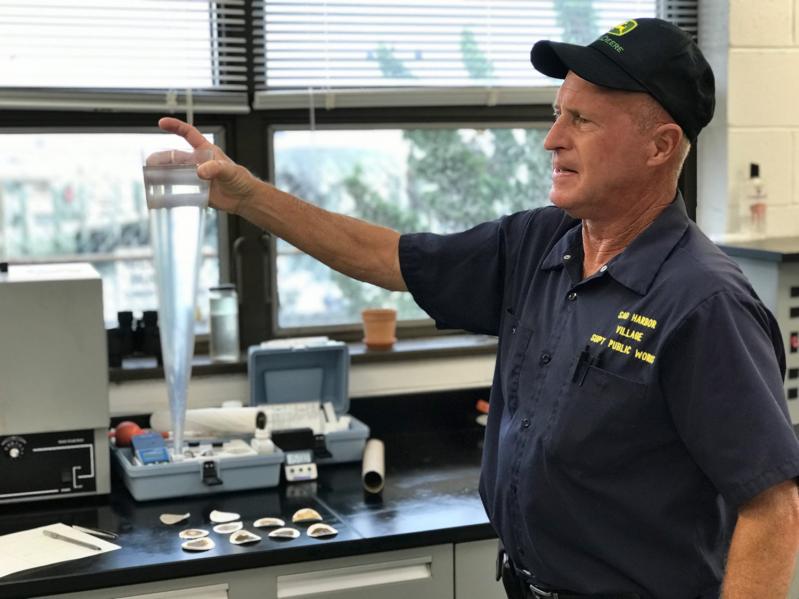Tucked improbably between two yacht clubs in Sag Harbor is a wastewater treatment plant, its sizzling open-air pools of excrement a thing of beauty if you’re looking at them in the right way. It can treat 250,000 gallons of wastewater daily, though it rarely gets past 180,000.
Without the plant, Sag Harbor couldn’t support the diversity of restaurants and cafes that add to the village’s popularity and character. The waterfront would also certainly have much higher levels of nitrogen and harmful bacteria, reducing its quality and vibrancy.
At Tuesday night’s Sag Harbor Village Board meeting, Aidan Corish, the board liaison to the plant, noted that an 88,000-gallon increase treated by the plant from July to August represented the increased “amount of business being conducted in the bars and restaurants.”
In East Hampton Village, the quest for a wastewater treatment plant hit a blockage when Mayor Jerry Larsen’s plan to place it beneath the Reutershan Parking lot was rejected by the State Department of Environmental Conservation late last year. The village has pivoted to looking at 172 Accabonac Road, home to its Department of Public Works and outside village limits, for the plant. “The ball is in our court to make a presentation to the town,” Mayor Larsen said by phone last week.
The Sag Harbor plant’s presence is only rarely belied by odors if the wind blows east at the same time tanks of solid waste are being transferred to trucks that cart it west. The transfer happens roughly once a month during the offseason, and twice monthly during the summer.
Perhaps shockingly to the uninitiated, treated wastewater is dumped directly into the bay behind the plant, in view of the Breakwater Yacht Club sailing camp. Kids sail by in close proximity, but Dee Yardley, the superintendent of public works for the village, keeps a tight rein on quality control at the plant and says the treated water is often close to 99 percent free of nitrogen and pathogens.
An April 2022 report by Christopher Gobler, from the Stony Brook University School of Marine and Atmospheric Sciences, available on the village’s website, said the plant does a great job of reducing nitrogen loads in the bay, but that it was “likely a minor source of” fecal contamination, along with boats and street runoff, within the inner harbor. (When fecal coliform is present, it indicates that other, more harmful pathogens present in the excrement of warm-blooded animals, like humans and dogs, is around as well.) In fact, Mr. Gobler highlighted the sump at Havens Beach as having “high levels of fecal bacteria.”
“Without the bugs, nothing happens,” Mr. Yardley said last week, while staring down into a tank of excrement. “There’s a natural process going on, we just speed it up 10 times. We air it up, then shut the air off and let the bugs do their work, de-nitrifying.” The “bugs” are microscopic bacteria that the plant is always monitoring to make sure they’re present in the correct diversity and number.
A sizzling sound came from millions of tiny bubbles appearing and disappearing atop the surface of the pool as it was aerated.

“We have no pumping stations here,” Mr. Yardley said, over at a “wet well,” the first stop in a tour of the plant. The entire system is gravity fed. “1975 vintage. They figured it out then and it’s worked fine ever since. If you’re at Il Capuccino’s and you flush the toilet, it’s here in 10 minutes.”
Once the contents of a toilet make the dark voyage through the pipes under the village and reach the treatment plant, they meet a “grinder” that removes anything odd like eyeglasses or iPhones. “We found a nightlight once,” said Mr. Yardley. “We plugged it in. Still worked.”
From there, the excrement enters a dry well dubbed “missile silo number two” by Mr. Yardley, and is pumped up to a “doghouse,” next to the tanks. The tanks are above ground because the groundwater is so shallow. Inside the “doghouse” the waste pours down over a large, screened wheel that spins slowly, capturing “anything the bacteria can’t break down,” like cigarette butts and sanitary wipes. Next to the doghouse is the “sludge tank” where the waste that cannot be processed gets stored before it’s shipped away.
“This week we had 28,000 gallons of sludge go out,” he said. “That’s like molten lava. You can get a stiff smell when the tractor trailers show up to take it away. But we took in 1.7 million gallons of waste. We do 30 million gallons a year, this little plant.”
Duly decluttered, the liquid makes its way into one of the five large tanks, where it is processed. It’s all regulated by computers, which are measuring the amount of waste in each tank and how far along it is in the process. Mr. Yardley pointed out one tank that was getting aerated, while another was in mix mode.

Staring into the abyss, as it were, it was hard not to think of Willy Wonka and Augustus Gloop falling into the chocolate river. Mr. Yardley pointed to a lifesaver nearby, only half a joke. In one tank, he pointed out a slick of fats and oils from a village restaurant whose grease trap hadn’t been pumped. “We’re pushing this law to fine people for not pumping their grease traps. It’s a killer for all sewer plants, not just this one.”
Indeed, after closing a public hearing on the law, the village passed it Tuesday night. The new law compels grease trap owners to maintain documentation of cleanings and if there’s an issue, they can be fined and charged for work undertaken by the village to clean their trap. Not a single restaurant owner attended the meeting, even though they were specifically invited by the board. “I think this law is important to protect our infrastructure,” said Mayor Tom Gardella.
Once the wastewater is denitrified, it travels through 48 ultraviolet lights, that “kill the bacteria before it goes out the back door,” the back door being the bay. The lights kill the fecal entero coliform. “Back in ‘75 they were going to put a pipe from here to the breakwater, but it was too much money and it just never happened. There’s no talk of that being done now,” he said.
“The whole idea of this place is to catch the solids, get your nitrogen out, and knock the fecal coliform out before it goes out the back door.”
Inside the plant, Mr. Yardley introduced Fran Schiavoni, a licensed sewage treatment plant operator, hunched over a nearby computer, monitoring the tanks. Mr. Schiavoni produced a piece of paper full of numbers. “In July, 3.17 million gallons came into the plant, and we pulled out 55,000 gallons of sludge,” he said. He subtracted the sludge, multiplied by 100, “that gets your decimal in order” and then divided by the total. “We had 98.27 percent clarity. That’s way good.”
Past that was a lab full of beakers holding water with varying levels of clarity.
“That’s what’s coming in, that’s what’s going out the back door,” said Mr. Yardley, comparing two beakers. He held the processed beaker next to a water cooler. “Sometimes it’s even better looking than the Poland Spring,” he said, smiling.
He showed off a 1975-era generator — “to replace it is 225 grand, and it’s never given me a lick of trouble” — and then a closet full of wires — “The brain is in there somewhere” — before heading back outside.
“This is like my little prison, we even have barbed wire,” he said, gesturing toward the rusted deterrent along the top of a chain link fence. “Most people don’t know I’m here, which is great, unless they smell something.”
He pointed to a large black tank, an odor scrubber that cloaks the smells emanating from the sludge tank. The plant cycles through different scents. “My whole purpose is not to smell here. I want you to smell oranges, or cherries, or whatever the flavor of the week is,” he said.
“When I get someone here saying, ‘I smell cherry smash,’ I’m happier than a pig in shit.”




